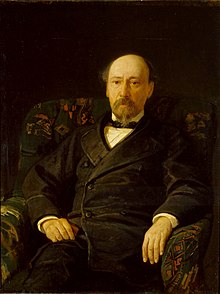Nikolay Nekrasov | |
|---|---|
 Nekrasov in 1870 | |
| Born | Nikolay Alexeyevich Nekrasov 10 December [O.S. 28 November] 1821[1] Nemyriv, Bratslavsky Uyezd, Podolia Governorate, Russian Empire[1] |
| Died | 8 January 1878 [O.S. 27 December 1877] (aged 56)[1] Saint Petersburg, Russian Empire[1] |
| Occupation | Poet, publisher |
| Language | Russian |
| Nationality | Russian |
| Spouse | Fyokla Viktorova |
| Signature | |

Nikolay Alexeyevich Nekrasov (Russian: Никола́й Алексе́евич Некра́сов, IPA: [nʲɪkɐˈlaj ɐlʲɪkˈsʲejɪvʲɪtɕ nʲɪˈkrasəf] , 10 December [O.S. 28 November] 1821 – 8 January 1878 [O.S. 27 December 1877]) was a Russian poet, writer, critic and publisher, whose deeply compassionate poems about the Russian peasantry made him a hero of liberal and radical circles in the Russian intelligentsia of the mid-nineteenth century, particularly as represented by Vissarion Belinsky and Nikolay Chernyshevsky. He is credited with introducing into Russian poetry ternary meters and the technique of dramatic monologue (On the Road, 1845).[2] As the editor of several literary journals, notably Sovremennik, Nekrasov was also singularly successful and influential.[3]
- ^ a b c d Nikolay Alekseyevich Nekrasov. Encyclopaedia Britannica.
- ^ Cizevskij, Dmitrij (1974). History of Nineteenth-Century Russian Literature. Vanderbilt University Press. p. 104. ISBN 0826511880
- ^ Zhdanov, Vladimir (1971). "Nekrasov". Molodaya Gvardiya Publishers. ЖЗЛ (The Lives of Distinguished People) series. Retrieved 13 January 2014.